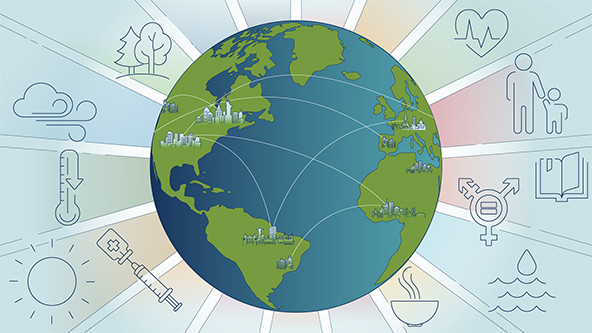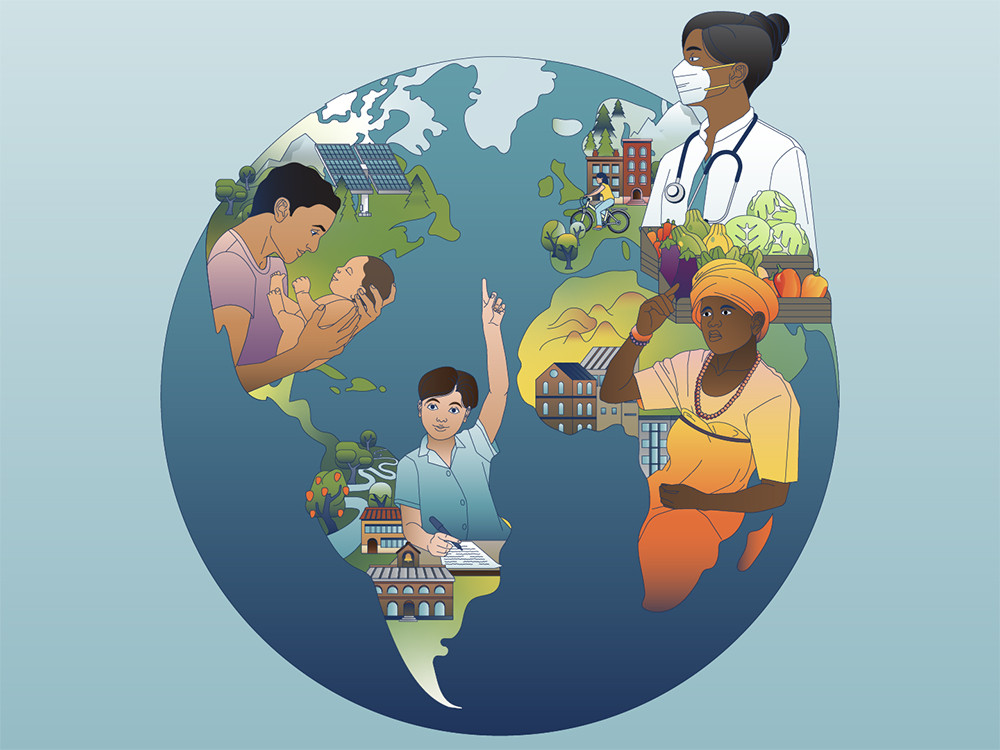 (Illustration courtesy of the Robert Wood Johnson Foundation)
(Illustration courtesy of the Robert Wood Johnson Foundation)
As of 2019, the United States was not on track to achieve a single Sustainable Development Goal (SDG) by 2030. Trends across multiple indicators linked to SDG targets, such as maternal mortality, overdose and suicide rates, and proficiency in reading and math, suggest that the future health and well-being of American youth, women, and minority racial and ethnic groups are particularly at risk. Yet the United States has mostly ignored any relevance of the SDGs to its domestic priorities. It is one of only five countries not to have submitted a review of its progress at the United Nations (UN).
By contrast, several US cities have been at the forefront of adapting the SDGs to accelerate solutions to local problems while contributing to global progress. For example, New York City created the innovative concept of a Voluntary Local Review (VLR), based on the Voluntary National Reviews that nations submit to the UN, in which local and regional governments adopt and track their progress toward the SDGs. Their innovation has in turn launched a global movement, with more than 200 local governments worldwide submitting VLRs.

Encouraging as well is US cities benefiting from the lessons and innovations shared by a diverse set of global peers—from Global North and Global South, cities large and small. While facilitating the Brookings Institution’s SDG Leadership Cities Network, which has brought together senior officials from 20 vanguard cities around the world to help accelerate their progress on sustainable development issues, we have seen firsthand how the regular exchange of experiences, challenges, and innovations has resulted in pragmatic action and new initiatives. Relying upon the universal nature and common language of the SDGs—and inspired by their interactions and relationships with their global counterparts —the participating US cities have become acknowledged leaders in taking on tough transnational issues through local action.
Their experiences show how the interdependencies of the SDGs come to life at the local level: Ending homelessness requires addressing issues of poverty, mental and physical health, quality employment, environmental justice, and climate change—in addition to safe and affordable housing. The activities of these cities demonstrate the relevance of the SDGs in the United States and their utility as a platform from which scalable multidisciplinary solutions on a wide range of issues might grow.
Creating Inclusive Governance to Build Political Momentum
In the United Kingdom, Bristol’s city government used a commitment to the SDGs to develop its unique One City Approach in 2016, a new model of governance that offers an active leadership role to outside partners in achieving the city’s priorities. A renowned leader on environmental issues—winning the Green Capital Award in 2015—Bristol is also marked by historic social and racial disparity: A 2017 report by the Runnymede Trust, a racial equality research group, ranked Bristol as one of the most unequal cities in the country.
Through the One City Approach’s community convenings and resident consultations, the city government identified a set of priority development outcomes across six themes: children and young people, economy and skills, environment, homes and communities, transportation, and health and well-being. These priorities led to the creation of the One City Plan in 2019, with targets, metrics, and aspirations aligned to the SDGs.
A set of new multistakeholder boards for each of the themes offer an official forum to grapple with the interconnections across issues, work out differences, propose solutions, and create buy-in to take action. This governance structure means the private sector, civil society, and university leaders are at the table, helping to shape the priorities and create new initiatives for each of the six themes, pulling their own weight on the city’s priorities. This collaborative approach also enabled rapid response and widespread support for Bristol’s economic recovery strategy from the COVID-19 pandemic, which puts a concentrated spotlight on improving equity even while taking aggressive action on climate change.
Through the two cities’ relationship in and beyond the SDG Leadership Cities Network, this multistakeholder approach stood as a model for local leaders in Orlando and across Central Florida as they sought to drive regional collective action on sustainability, resilience, and social issues.
Several local institutions in Central Florida had been using the SDGs for their own purposes and were interested in building wider collaborative momentum to improve outcomes on a range of issues, such as safe and affordable housing, health, and clean and reliable transportation. The city of Orlando began integrating the SDGs into its sustainability plans in 2018 and released a first-ever Voluntary Local Review (VLR) in 2021 to report its progress against the SDGs. Simultaneously, the Central Florida Foundation launched the Thrive Central Florida initiative in 2020 with five philanthropic funds to drive investment to address key community-level concerns, and the East Central Florida Regional Resilience Collaborative (ECFR2C) developed a Strategic Resilience Action Plan in 2019 in collaboration with over 40 partners and different jurisdictions across the region.
Informed by the Bristol experience, these partners, in conjunction with leaders from Orange County and the University of Central Florida, recognized that breaking down the traditional boundaries that separate sectors and issues could have a powerful effect. Using the SDGs as a common platform, they hosted a regional collaborative exercise using the 17 Rooms methodology to bring together representatives from Central Florida’s public, private, academic, and nonprofit sectors across the full range of issues reflected in the SDGs. Developed by the Brookings Institution and the Rockefeller Foundation, the 17 Rooms process uses the SDGs as a basis for enabling groups to identify collaborative, multidisciplinary, near-term actions that will contribute to sustainable development progress.
The effort helped leaders in different domains find points of common cause—for example, the importance of targeting broadband access to improve health outcomes—and reaffirm the power of participatory engagement, resulting in a wide range of concrete actions and proposals to take forward together. These range from policy changes to address the fiscal cliff as safety net benefits drop because of increased income, to a youth-led campaign on healthy eating, to workforce development for green industries to expand jobs, diversify local economies, and lessen carbon emissions.
Leveraging Spending Power for Social Impact
The SDGs combine targets and metrics, which cities have found useful for evaluating how their spending aligns to environmental, economic, and social policies. This allows for data-driven decision-making by local governments as they deliver key services to their residents.
The Swedish city of Malmo revamped its budget and management systems to integrate the SDGs, creating a process to monitor and evaluate its spending across its policy priorities. This shift forced Malmo to stretch its budgetary goals across four years to coincide with mayoral terms, as well as modify its procurement processes to integrate social impact objectives. Combining their budget and policy processes not only helps Malmo better align its spending with its long-term objectives, it also helps the city gain new insights into the types of interventions that are most effective in achieving results. The city now consistently monitors the status of budgetary items against SDG-aligned targets to inform the following year’s budget and stay on track.
Pittsburgh, Pennsylvania, with their own mayoral commitment to the SDGs made in 2019, began building a relationship with Malmo across various global networks. Familiar with the Malmo experience, as well as others like Stockholm and Oslo, as a post-industrial city with ambitious climate and equity goals, city officials in Pittsburgh were inspired to pursue a new method of priority-based budgeting based on their sustainability objectives.
Using this approach, Pittsburgh began an assessment of how its spending aligns to its commitments to equity and climate action in the fall of 2020. The city government identified $23 million in its existing budget that could be reallocated to better support its priorities. Based on this first-ever priority-based budget, city departments are identifying the changes needed to concrete spending items to advance city priorities. In one small example, they reallocated $50,000 simply by removing paper contracts. Not all reallocations will be as easy, but as the city’s departments dig more deeply into opportunities, it hopes to annually reassess its spending and accelerate its progress on equity and climate targets.
Joining Together to Accelerate Progress Locally
These experiences through the Brookings SDG Leadership Cities Network are emblematic of the growing participation of cities in issue-specific networks to exchange knowledge, best practices, and innovations. The SDGs increasingly provide the glue and enable a collective mentality where the local contributions of cities are influencing global norms and policy, all while offering US communities ideas for doing things differently.
Los Angeles used this to its advantage to advance a strong commitment to gender equity established through three executive directives by its mayor. Recognizing that no platform existed for exchanging with its peers on how to use the unique authorities of local governments to impact marginalized genders, the city became a key founding member of the City Hub and Network for Gender Equity (CHANGE). To create its own metrics, Los Angeles drew upon the work of Buenos Aires to develop a measurement system that assesses gender gaps across physical, economic, and decision-making dimensions. Bogota’s groundbreaking CARE blocks, which provide child care and elder services to relieve caregivers (a large majority of whom are women) and give them the opportunity to participate in the local economy, provided an innovative model to update city services. Los Angeles also benefited from the network’s Gender Equity Toolkit, which offers a menu of best practices defined by the major functions of local government, and the network’s Voluntary Gender Review, a first-ever report incorporating lessons, challenges, and new approaches to improving gender equity in various local contexts around the world.
Can cities drive national and global action? Only with federal partnership.
The US federal government is increasingly recognizing the value of this local leadership. In October 2022, Secretary of State Antony Blinken named Ambassador Nina Hachigian as the first-ever Special Representative for City and State Diplomacy. The United States, in conjunction with Denver, just hosted the first-ever Cities Summit of the Americas, where it launched a Cities Forward initiative to pair US cities with Latin American counterparts to create sustainability action plans and advance resilience, health, and welfare in underserved communities.
But city governments alone can’t reverse the troubling trends that threaten the health and well-being of too many in the United States. The movement of US cities to embrace the SDGs, often inspired by and in collaboration with counterparts across the globe, provides a road map for a clear national commitment by the US federal government.
An unambiguous, public pledge by President Biden to pursue and measure progress against SDG targets and benchmarks would create the basis for a stronger partnership across the three levels of government —city, state, and federal—to reach the communities and people being left behind in the United States while accelerating action on climate and environmental issues. Submitting a review on national progress against the SDGs would provide credibility to US global leadership on issues ranging from hunger and poverty to corruption and democracy, as well as climate change and biodiversity. It also opens up the possibility for greater learning from national counterparts across the globe, to import innovative practices, do things differently, and create new partnerships.
US cities have blazed the trail. It is time for the federal government to follow that path and take up the SDGs alongside its peers, leveraging its substantial political and economic weight to spur important progress across the country and around the world.
Support SSIR’s coverage of cross-sector solutions to global challenges.
Help us further the reach of innovative ideas. Donate today.
Read more stories by Anthony F. Pipa & Kait Pendrak.

